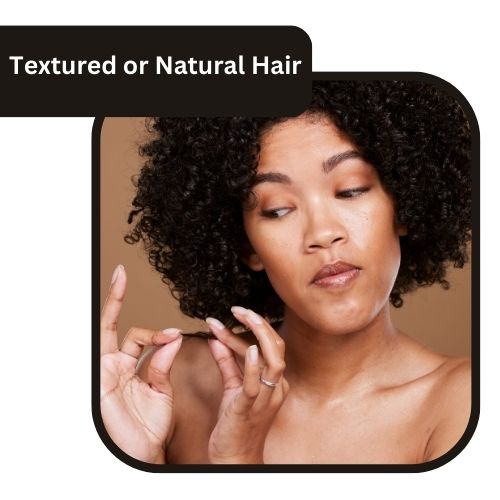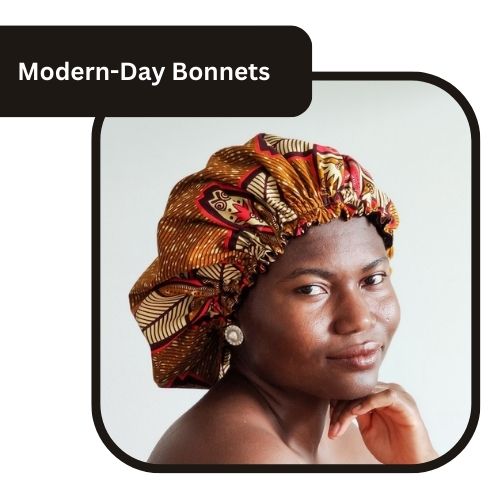Like egg crates are for eggs, silk bonnets are helpful accessories made from satin or silk, providing a way to protect your precious black hair. Their texture allows your hair to glide easily against the fabric without friction or absorbing moisture.
Alternatively, when you use cotton fabric to wrap your hair, it soaks up the little moisture in the hair, causing friction that results in breakage and split ends.
Hence, black women wear bonnets and headscarves to prevent moisture loss, hair breakage and protect their kinky hair or hairstyles.
Also Read: 70+ Incredible Natural Hairstyles for Black Women
The Purpose of Hair Bonnets
Reducing Friction
When your hair is in friction, it explains the resistance it encounters when two strands of hair or hair fibers rub against each other. This is due to the texture, thickness, and condition of the hair. Hair friction can also occur due to external factors such as humidity, temperature, and styling products.
Friction can cause hair to tangle, leading to knots, breakage, and damage. To minimize hair friction, you need to maintain hair moisture balance, use appropriate hair care products, adopt gentle handling techniques, and employ protective measures like wearing hair silk bonnets before bed.
It Prevents Tangling
A hair knot essentially develops when two individual hair strands wind themselves around one another and entwine.
The quickest and simplest way to stop your hair from tangling is to wear a hair bonnet to bed. Simply tuck your hair away, and you can wake up to a morning mane that is much easier to manage.
It Reduces Frizziness
When hair stands up or curls on its own rather than aligning with the hair around it, it is said to have frizz. Bonnets, therefore, reduce the amount of frizz you wake up with and prevent knots, thinning, and breakage.
Bonnets Keep Hair Hydrated
While it’s comfortable to sleep on soft, smooth cotton sheets, they also absorb all the moisture from your hair. Silk is used to make hair bonnets, which keep your hair moisturized and prevent conditioning products from soaking into your pillowcase.
It Protects Hairstyles
In particular, people with black hair often lack the time needed to style their hair in the morning. Hair bonnets, particularly satin ones, keep your braids and curly hairstyles looking youthful and new.
It Helps Lock in Moisture
It is more likely that your pillowcase will absorb your favorite hair oils, serums, and leave-in conditioners than your hair when you use them at night.
Any hair products you use before bed will work overtime to nourish, smooth, and condition your hair with the aid of a hair bonnet.
It Helps Prevent clogged Pores
It is likely that you are unsure of how a bonnet cap can improve the look of your skin, but consider this! The surface of your pillowcase absorbs all of the natural oils and styling products from your hair, which then gets transferred to your face. It’s a recipe for skin irritation, blocked pores, and breakouts.
Hair bonnets are a great way to keep your skin clear and your pillows clean.
Also Read: Why do Black Girls Wear Wigs? The Pros and Cons
Unique Characteristics of Textured or Natural Hair

Natural hair is unlike any other. It’s extremely fragile and requires a little more love. It has bends and twists that make it even more vulnerable to manipulation.
The following are some unique features of black hair:
1. Slow Hair Growth
African hair is characterized by both slow hair growth and low hair density, according to L’Oréal.
The scalp produces a natural oil called sebum. Sebum can easily slide down the hair shaft for those with straight hair. However, kinkier hair has an even harder time keeping moisture in, as does hair that is curlier.
The reason is that it’s much more difficult for the sebum—a thick waxy oil—to travel down the twists and coils of our hair to the ends. Moisture also has a difficult time moving up the hair shaft, not just sebum.
And when the hair is mostly dry, it’s challenging to grow at a faster pace.
2. Prone to Breakage
Lack of moisture leads to breakage in black hair. Products aside, the hair’s natural “greasiness” or “oiliness” is usually what keeps the hair strands shiny and protected from outside elements like the sun or friction. The natural oil, sebum, also aids in preserving the ends, thus preventing breakage.
3. Cubicle Layers are Raised in Kinky Hair
The outermost layer of the hair shaft is called the cuticle, and it is made up of overlapping scales that protect the inner layers. In comparison to straight hair, the cuticle layers in kinky hair are higher and have a looser structure.
As a result, kinky hair becomes more porous and is more easily permeable to moisture. External factors like heat, humidity, and environmental damage can more easily penetrate the hair shaft and steal moisture because of the raised cuticles.
Also Read: Why do Black People Have Big Lips? Everything You Need to Know!
The Tradition of Hair Coverings in Black Culture

Headwraps can be traced back to Africa in the early 1700s and soon became prevalent among Nubian queens in Egypt. Depending on their color and pattern, headwraps had different meanings.
At the beginning of the 18th century, headwraps communicated a black woman’s culture and family practices. For some cultures, headwraps are associated with high social status, along with a woman’s marital status.
In some tribes, married women wear headwraps when visiting their in-laws as a sign of respect. Other ethnic tribes wear headwraps when attending religious gatherings.
By the mid-1700s, in the US, headwraps became a symbol of slavery to identify Black women. In South Carolina, British colonists passed a law in 1735 that directed Black women to wear specific types of clothing. They were not permitted to wear decorated or embellished clothing, including festive headwraps.
In 1784, the then Louisiana Governor, Esteban Rodriguez Miró, passed the “Edict of Good Government”. This required Black women to wear their hair bound in a kerchief, or “tignon.”
Thus, what began as a fashion statement of opulence became a symbol of oppression.
Also Read: Why Do Black People Smell? A Myth or Truth!
Historical And Cultural Significance Of Headwraps And Other Hair Coverings

Headwraps were traditional attire in most African regions. In Ghana and Namibia, for instance, people refer to headwraps as dukus and doek, respectively. The way you wear a headwrap reveals your socioeconomic status, race, marital status, emotional state, and other aspects of your identity.
Even so, headwraps had a dark past despite their functional and cultural significance in the 1800s. As previously mentioned, bonnets and headcovers were turned into weapons during slavery. They were employed to clearly show Black women to be inferior.
However, black women found a positive use for their headwraps in parts of Central America. They use the folds in their headscarves to communicate coded messages to one another that their masters couldn’t understand.
Black women continued to frequently use headwraps after the end of slavery to keep their hair in place, but the stigma attached to them persisted.
Transition to Modern-Day Bonnets as a Practical Alternative

When slavery was abolished in the 19th century, headwraps underwent yet another negative development when Black women wearing them appeared in popular American advertisements, furthering the “Black Mammy” stereotype.
As a throwback to the days of slavery, this stereotype propagated the myth that black women were only good at working as housekeepers and cooks.
As a result, Black women began to abandon headwraps altogether due to their association with servitude and slavery.
Following the invention of chemical relaxers in the early 20th century, Black women started to embrace headwraps once again. As the popularity of hair extensions grew, Black women wore satin-lined bonnets to protect their hair from heat, moisture loss, and humidity.
The use of bonnets is even popular among Black men, who started to sport headwraps to preserve their hair specifically designed for men known as ‘durags’.
Also Read: The Story of NCBLG: An Oasis for Black Queerness
There you have it…
The rich cultural history of headwraps reveals that they are much more than just hair ornaments. When Black women began wearing headwraps in 18th century Africa, they did so to express their Black womanhood.
In colonial America, headwraps were viewed negatively, but Black women reframed the narrative by wearing them as a powerful symbol of self-love and to protect their unique kinky hair.
Read Related Articles:
